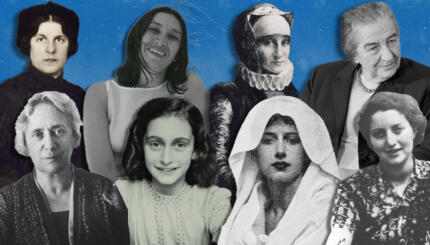In the fortunate cases it is the grandparents, often it is the parents, and sometimes even a sibling who stands before the congregation and presents a tallit. Early in the service, the child celebrating becoming bar or bat mitzvah the tradition is literally handed down generation to generation. As the child takes the sacred object from their elders and wraps about their shoulders, the message of the day is clear. Just as I have done, you too shall do too.
Continuity has a power of its own. It is wondrous to see grandsons and sons stand side by side with fathers and grandfathers that are similarly wrapped. But even today rare is the grandmother or even the mother who covers the top of the beautiful outfit with a tallit. Yet, the girls in my community, with only the exception of those who affiliate Orthodox, not only wear a tallit on the day they celebrate becoming bat mitzvah but make it part of their regular religious garb. They are breaking new ground.
The tallit has become a symbol of not only of continuity but also of change.
On the rare occasions when I attended synagogue as a child, my father’s tallit was both a refuge and a source of entertainment. But when it came time to celebrate my coming of age, the mere fact that I would chant Torah (with my father saying the blessing with me—lest the agency be mine entirely) was so radical that we had to travel far from home to find a rabbi willing to allow it. A girl wearing a tallit was literally unthinkable.
At the start of the Jewish feminist movement, women and girls battled and largely won the right to take their place at the Torah. But when it came to adopting the ritual wear that historically goes with the privileges and opportunities of Torah reading, the issues were significantly more complex. In part, I suspect that there was a desire to push forward but not too much. Even as Jewish women asserted their power they did not want to ‘be men,’ as they were often accused of being. In addition to the historic prohibitions on women reading Torah, there are prohibitions against women taking on ‘the dress of men.’ Furthermore, 30 years ago the Reform movement, which played a significant role pioneering change, did not encourage ritual garb regardless of gender.
Today in most communities—even Orthodox ones—the place of women next to the Torah is no longer a question. But change is happening when it comes to tallit.
I bought my first tallit in my early 20s. It was large, woolen and woven like my fathers but had colored stripes instead of the traditional blues and blacks. It was as wildly different as the very fact that I dared wear such a thing. Today, as I shop with my daughter ahead of her being called to the Torah, I am struck by the array of feminine materials, cuts, colors and designs that she has to choose from in addition to the more historic types. No one would confuse a lace pink flowery tallit with the ‘dress of men.’ The modern bat mitzvah can choose a tallit that both expresses who she is as a person as well as her pride in her tradition.
Each time I attend bat mitzvah service in different synagogues of my community, I am struck by the passing on of the tallit. More than with the boys, this moment with the girl and her family encapsulates my hope for the next generation of Jews—regardless of gender. Wrap yourself in our tradition but make it your own and don’t be afraid of making change.
bat mitzvah
Pronounced: baht MITZ-vuh, also bahs MITZ-vuh and baht meetz-VAH, Origin: Hebrew, Jewish rite of passage for a girl, observed at age 12 or 13.
mitzvah
Pronounced: MITZ-vuh or meetz-VAH, Origin: Hebrew, commandment, also used to mean good deed.
tallit
Pronounced: tah-LEET or TAH-liss, Origin: Hebrew, prayer shawl.
Torah
Pronunced: TORE-uh, Origin: Hebrew, the Five Books of Moses.



